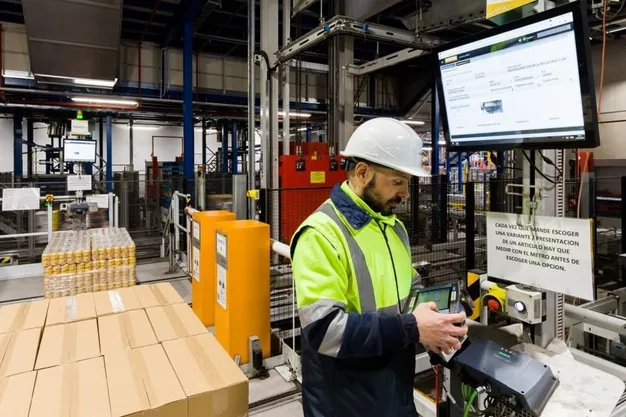The majority of traditional warehouses need employees to lift manually and transport the crates that contain goods, which typically weigh a lot. The repetitive twisting, turning and bending puts warehouse employees constantly at risk of injuries and could result in permanent physical injury. In particular, during times of labor shortfall, manual fulfilment of orders means that warehouse workers have to perform more work and move more quickly, which increases their chance of injury in the workplace. Through removing ergonomic risks Automation marks the transition away from the physical demanding warehouse into more contemporary facilities with more efficiently, quicker and with safer processes.
Fresh produce crates are processed by robots
Healthy workplace means productive workforce
Ergonomics isn’t only a trendy term. Indeed, the well-being of employees as well as safety are the main reasons for the decision to automated distribution facilities, as well as more reliability and security in distribution. An environment that is safe for employees leads to better health for employees, less risk of injury, lower stress, and better retention of employees.
“Crates that are handled by hand tend to be very heavy,” explains Kari Miikkulainen director of Warehouse and Distribution Industry Sales at Cimcorp. “In supermarket distribution employees, for instance, might be lifting crates full of fruits and vegetables that weigh up to 25 kg. A truck can be packed up to 2 metres high. To carry heavy crates up at this level is extremely demanding for our bodies in addition to potential safety concerns.”
Kari Miikkulainen Director for Warehouse and Distribution Industry Sales at Cimcorp
Alongside the ergonomic issues, inadequate employees can increase the stress that can affect manual distribution. Making investments in safety at work is crucial to protect that employees are safe and remain at the forefront of competition. Hours lost due to accidents can reduce the efficiency and productivity of warehouses.
Automation improves operation and security
Automation can create a more secure workplace because it removes high risk tasks of workers. It also gives the opportunity to streamline the entire distribution centre with system integration. From conveyors, autonomous vehicle guided (AGVs) and the automated storage and retrieval system (AS/RS) and order-picking options, robots and machines will ease the burden of fulfillment. The automated systems can facilitate quick and precise movements of merchandise – starting from the point of receiving to storage, replenishment and securing, through packaging and shipping, thereby optimizing process flow from the beginning to the end. By utilizing automated warehouses, distribution centers are able to reduce the dangers of injuries, reduce stress on employees because of absences, and offer better employee satisfaction.
 Automation propels employees into supervisory positions
Automation propels employees into supervisory positions
“Automation will ease the physical stress on employees and help them advance to new technical or managerial roles. The result is that automated technology does not just address the gaps in operations caused due to the widespread shortage of labour, they also provide current workers through more rewarding, technologically driven jobs. Automation can therefore provide an enormous increase in ergonomic conditions as well as the outlook for distribution centers.” claims Kari Miikkulainen.
More information is available here:
Maarit Leppaaho
Cimcorp
Tel: +358 10 2772 000
www.cimcorp.com
Source: The Plantations International Agroforestry Group of Companies
